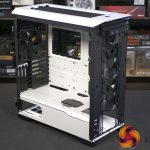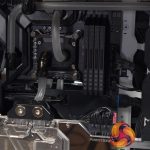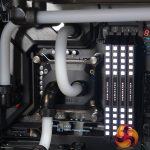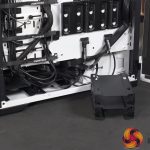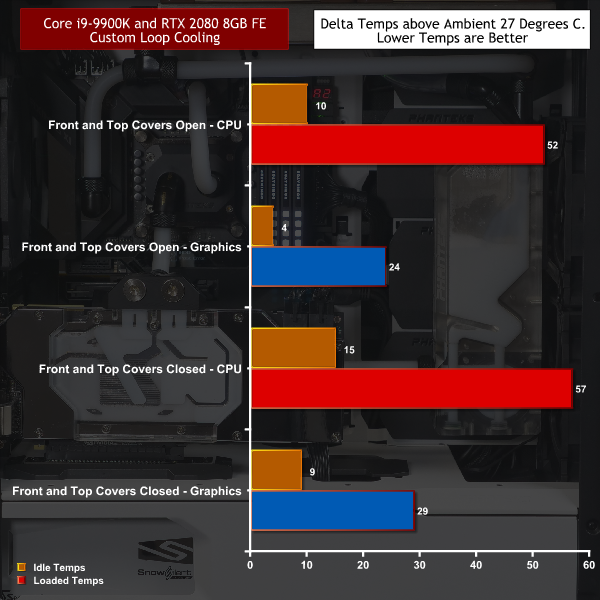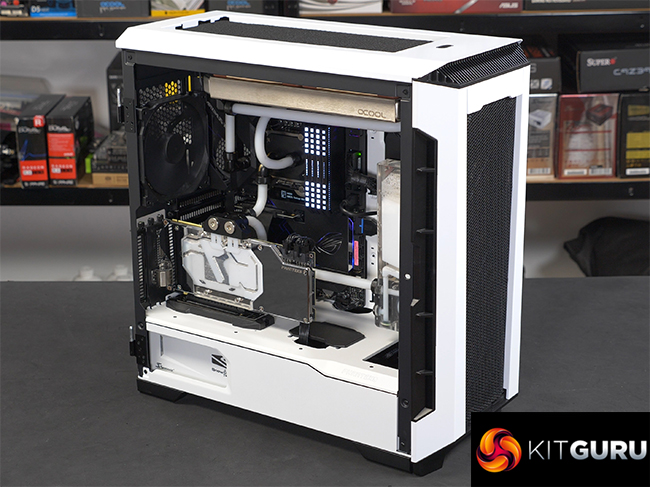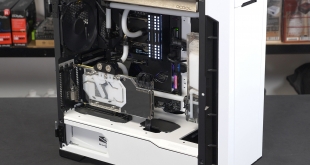
Phanteks Eclipse P600S is a hybrid mid-tower case that can switch between Silent and High-Performance modes and comes with the bold new Phanteks fabric air filtration system. The P600S uses the same core chassis as the Evolv X (a case we love dearly) while the list of features has been pruned to hold the price at a sensible level.
When we reviewed the Phanteks Evolv X we were impressed by the long list of features, the options you could employ during your build and also loved the integrated RGB. The 3mm aluminium panels were a major part of the look of the Evolv X and as a result we fully understood the £200 price tag.
We have since seen Evolv X on sale at £180 but no matter how you cut it that is a fairly high price to pay. Our single biggest reservation about Evolv X is that it might be too much case for the mainstream PC builder, so a budget version of the Evolv X sounds like a fine proposition and that is where the Eclipse P600S enters stage left.
In essence Phanteks has taken the core chassis from the Evolv X, removed the integrated RGB and ditched the second glass panel and the cable management doors. Those would be significant changes to cut costs and would perhaps result in an Evolv X Lite. Instead Phanteks has gone further and has removed the aluminium panels and replaced them with steel panels on the top and front that give rise to the hybrid nature of the case.
Each panel has a cover that is held in place with magnets so you can leave them in place and benefit from their noise deadening material or you can remove them to expose the fabric mesh panels to improve air flow.
The P600S is available in Glacier White, Satin Black or Anthracite Grey with a Tempered Glass main window for £134.99 or you can have a cheaper black version with an insulated panel (i.e. no glass) for £127.99.
Using the core chassis from the Evolv X means the P600S supports a number of Phanteks accessories such as their ITX kit that allows you to install dual PCs in the chassis. If you want to use Phanteks RGB products in the P600S you will need to add an RGB controller.
Note: if the above images are not displaying properly, you may need to disable Ad Block as it is known to interfere with our display code
Specification:
Motherboard support: E-ATX up to 280mm wide, ATX, Micro-ATX, Mini-ITX.
Expansion slots: 7.
Included fans: 1x 120mm front intake, 1x 120mm rear exhaust.
Fan mounts: 3x 120mm/140mm front, 3x 120mm/2x 140mm roof, 1x 120mm/140mm rear.
120mm radiator mounts: 120mm/240mm/360mm front, 120mm/240mm/360mm roof, 120mm rear.
140mm radiator mounts: 140mm/280mm/420mm front, 140mm/280mm roof, 1x 140mm rear.
5.25-inch optical drive bays: None.
Internal drive bays: 4x 3.5-inch, 3x 2.5-inch.
Dimensions: 520mm H x 510mm D x 240mm W.
We built a test system in the P600S with a full custom cooling loop but this time we stepped it up from our Evolv X build.
At the heart of the system we used an Asus ROG Maximus XI Formula motherboard with Z390 chipset and a water cooling system on the VRM hardware. For the CPU we naturally chose an Intel Core i9-9900K.
When it came to the custom loop we used Phanteks hardware for the main components, including a Phanteks R220 reservoir and DDC pump, Phanteks Glacier C350ip CPU block and a Phanteks Glacier G2080 Ti block on our RTX 2080 graphics card.
The P600S has plenty of space for radiators both at the front of the case and in the roof however we chose to install a single 280mm Alphacool NexXxos ST30 with a nickel plated finish. The radiator went in the roof, which meant we could use the removable radiator rack to ease installation. The radiator was connected to the inlet port on the top of the reservoir which meant we had no obvious way to fill the system with coolant. Our answer was to use a Y piece and to install a Corsair fill port in the radiator rack.
Testing
To put this case through its cooling paces we will be using a test system consisting of a Core i9-9900K, RTX 2080 8GB Founders Edition and an SSD. This system allows us to produce a substantial amount of heat and effectively test the cooling capabilities of the Phanteks Eclipse P600S. For stress testing we use AIDA64 to create the maximum amount of load our CPU and GPU are ever likely to see.
Test System:
Processor: 4.7GHz Intel Core i9-9900K
Motherboard: Asus ROG Maximus XI Formula
Memory: 32GB Corsair Dominator Platinum RGB DDR4-3200MHz
Graphics card: GeForce RTX 2080 8GB Founders Edition
Power supply: Seasonic Snow Silent Titanium 750W
SSD: Intel 1TB SSD 7 M.2
OS: Windows 10
Cooling system:
CPU block: Phanteks Glacier C350ip
Graphics block: Phanteks Glacier G2080 Ti
Radiator: Alphacool NexXxos ST30 280mm
Fans: 2x Noctua NF-A14 PWM
Reservoir: Phanteks R220 + EK DDC pump
Fittings: Alphacool 13mm
Tubing: Alphacool 13mm acrylic satin
Coolant: Thermaltake P1000 White Opaque
Cooling Performance.
Cooling Performance Overview.
You might think our chosen 280mm radiator would be on the small side to cool both an 8-core CPU and an RTX 2080 graphics card however past experience gave us confidence it would work well. Graphics temperatures were pleasingly low, despite the hot summer conditions, and the air flow of the case clearly works effectively. It should be noted that we added two Noctua fans in the roof of the case above the radiator, so we are not testing the case in exactly the form it was supplied.
Nonetheless we are confident the P600S works well in Performance mode with the panels open for maximum air flow. With the panels closed up in Silent mode the temperatures inside P600S rose by five degrees, which was rather less than we expected. The single biggest limitation on heat transfer and cooling is the design of the Intel Core i9-9900K which was running around 30 degrees hotter than the graphics card.
Acoustics Performance Overview.
With the panels opened up to allow the P600S to run in Performance mode we found the Phanteks had to potential to be quite noisy. That was with the fans running over 1,000rpm, however that was completely unnecessary. Once we controlled the fans in the BIOS using a nice, quiet profile the P600S was audible but not the least bit noisy. Truth be told the fan noise was slightly ominous, somewhat like a performance car that is cruising along at low rpm but with the potential to roar away with the merest whiff of the gas pedal.
We like almost everything about the Eclipse P600S and consider it was a clever move to create a budget version of the wonderful (but expensive) Evolv X. It seems like an obvious change to remove the second glass panel from the Evolv X and also do away with the cable management doors. The thing is, we doubt that change saved much cost as Phanteks has a knack for delivering tempered glass at a lower price than any other company we can think of.
Removing the RGB from Evolv X would also save some money, however that particular change makes us sad as the RGB system used by Phanteks is superb. Clearly there are people out there who don’t much care for RGB lighting and who doubtless applaud the change. There is good news for those people as they may well like to consider the budget black P600S that has no glass at all and looks for all the world like it came from be quiet!
The final change is the replacement of the aluminium panels on Evolv X with the two part panels you find on P600S that introduce fabric air filters. This is the most significant change from Evolv to Eclipse and is very much a matter of personal taste. We like the look of the Evolv X and admire the clever use of fabric in the filtration system of the P600S but cannot honestly say we love the aesthetic of the Eclipse. That thought leads us to the conclusion that you are best advised to stretch your budget and find the money for the Evolv X.
You may see things entirely differently. You may dislike the look of Evolv X and find the P600S is a smart and stylish case with a pleasingly sensible price. We fully understand that sentiment and certainly cannot say you are wrong. We prefer the Evolv X, however we acknowledge that is a matter of personal taste.
It is clear that Phanteks has reworked the Evolv X to create the P600S however they have done considerably more than simply slash the Bill Of Materials to reduce the price. Those new panels on the front and top are very clever and they show considerable thought and care. We applaud the Eclipse P600S but we prefer the Evolv X.
You can buy the Phanteks Eclipse P600S for £134.99 HERE
Pros:
- Plenty of options for your cooling system.
- Excellent cable management.
- Clever use of fabric in the dust filters.
- Glass door looks good and closes securely.
Cons:
- We miss the RGB found in other models of Phanteks.
- Price is slightly too high.
- Vertical graphics card mount appears to have some sag.
KitGuru says: Eclipse P600S is very clever but Evolv X continues to be the king of the mountain.
 KitGuru KitGuru.net – Tech News | Hardware News | Hardware Reviews | IOS | Mobile | Gaming | Graphics Cards
KitGuru KitGuru.net – Tech News | Hardware News | Hardware Reviews | IOS | Mobile | Gaming | Graphics Cards






